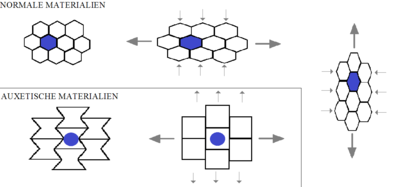
Un material augético (del griego auxein 'expandirse') es un material con coeficiente de Poisson negativo.
Introducción
Las restricciones termodinámicas de los sólidos deformables establecen que un material isótropo debe tener un coeficientes de Poisson comprendido en el rango . Por tanto, aunque la mayoría de materiales tienen coeficientes de Poisson estrictamente positivos , termodinámicamente es posible un coeficiente de Poisson negativo. De hecho, los materiales augéticos con coeficientes de Poisson negativo conocidos se agrupan en tres categorías:
- Cristales, como las zeolitas, que manifiesta propiedades augéticas en escalas microscópicas.
- Espumas poliméricas, como el teflón PTFE, que bajo ciertos tratamientos mecánicos y térmicos puede mostrar un comportamiento augético.
- Las fibras utilizadas en composites
El funcionamiento de estos materiales augéticos se explica a nivel microestructural.
Enlaces
- (Inglés) Materiales Augéticos


